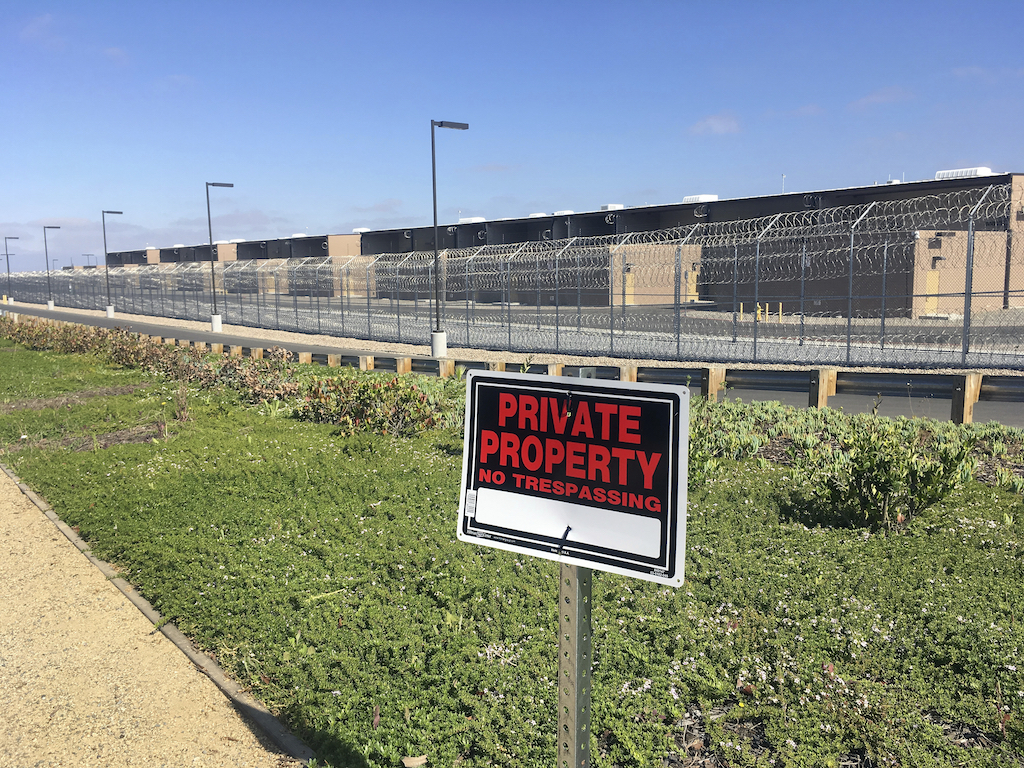Immigration Detention Centers Put Rule of Law to Shame
The Department of Homeland Security ignores thousands of complaints of sexual assault, abuse and harassment. Otay Mesa Detention Center in San Diego, Calif. (Elliot Spagat / AP)
Otay Mesa Detention Center in San Diego, Calif. (Elliot Spagat / AP)
Editor’s note: The story of America is the story of immigrants. But since Donald Trump became president, the immigration issue has become a humanitarian crisis in the United States. Truthdig political correspondent Bill Boyarsky investigates the impact of Trump’s anti-immigrant racism on Los Angeles—home to 1 million undocumented immigrants—in this ongoing series for Truthdig called “Demonizing the City of Angels.” You can read all of Boyarsky’s stories in the series here.
Of all the injustices in President Donald Trump’s immigration enforcement machinery, imprisoning immigrants in detention centers around the country is among the worst.
These are prisons—unnoticed by most—where immigrants who often have committed no crime are held in limbo, sometimes locked up for years in centers located in small towns far from their homes, families and friends. Their complaints of rape and other abuses are generally ignored. It’s all but impossible for these inmates to get a lawyer. They are trapped in an example of the police state methods the Trump administration would like to impose on the rest of us.
The centers have operated since the 1980s. They were expanded after the 9/11 attacks. Increasingly harsh treatment of immigrants continued under Presidents George W. Bush and Barack Obama but has intensified drastically in the Trump administration, which plans to build more detention centers, hire more immigration cops and make it easier to arrest and deport immigrants.
In January 2017, Trump issued an executive order telling immigration agents to not only deport those convicted of serious crimes—the Obama administration standard—but also those they believe have committed acts that “constitute a chargeable criminal offense.”
These people are placed in detention centers whose population includes many immigrants who have not committed any crimes at all. More than 400,000 immigrants are imprisoned every year in 249 detention centers under control of the Department of Homeland Security’s immigrant enforcement arm, Immigration and Customs Enforcement (ICE).
Some inmates are in the United States without documents that permit them to be here, which is a civil violation, rather than a criminal offense. Others have documents, including the green card, which gives them permission to be in the United States. But they may have come to the attention of ICE by driving under the influence, which in most cases is not a felony, or by committing lesser offenses.
Others are citizens, arrested by immigration cops suspicious of dark skins and accents and attracted by faulty brake lights or some other minor automotive defect. It’s up to these people to prove they are citizens. Do you carry your passport or birth certificate with you when you leave home? If you have a dark skin and an accent, you should.
In April, the plight of these immigrants got a rare airing when Community Initiatives for Visiting Immigrants in Confinement (CIVIC), an immigrant advocacy organization, filed a civil rights complaint with the Department of Homeland Security’s Office for Civil Rights and Civil Liberties. The complaint charged that Homeland Security received a total of 33,126 complaints of sexual and other physical abuse from January 2010 to July 2016, but only 225 were investigated.
“The data is particularly disturbing given that rape and sexual assault are known to be highly underreported in immigration detention facilities due to fears of retaliation, social isolation, language barriers and the knowledge that allegations are not seriously investigated,” said Rebecca Merton, independent monitor and program coordinator of CIVIC’s National Visitation Network.
CIVIC is one of a number of activist grass-roots groups that are standing up for immigrants. Its members verbally battle their way into detention centers to inspect them and to force reluctant jailers to permit relatives to visit the prisoners.
David Manuel Hernandez of UCLA explained in a paper that such jailings are considered administrative, not punitive, a fine point of law that allows ICE to keep such immigrants in detention, often for many months or even years. The immigrants, once detained, can continue to be held while immigration authorities investigate their backgrounds, searching for reasons to deport them.
“They are not being held for punishment of a crime,” Christina Fialho, CIVIC co-founder and executive director, told me.
“Many people we work with said immigration detention is far worse than prison, ” she added. “That’s because … it is not supposed to be punishment, (so) they are not protected by the laws. … Inmates there have no rights to a court-appointed attorney, no right to a phone call, no legally protected right to be visited by family and friends.”
The detention centers operate under a system that frees them from accountability for the conduct of the jailers who run them.
“Sexual abuse in immigration detention is clouded in secrecy,” CIVIC said in its complaint to the Department of Homeland Security. “People in immigration detention are afraid to file grievances for fear of retaliation, complaints are promptly closed or not investigated and government data on sexual abuse is routinely withheld.”
The secrecy is maximized by the way the detention centers are operated—mostly by two big private companies, the GEO Group and CoreCivic, which have contracts to run them. Detention center guards work for the private companies. “They don’t have good training for their guards, and since the whole system operates out of public sight, the guards who perpetrate this are going unpunished,” Fialho said.
I contacted ICE for comment on Dec. 21, but have not heard back. The agency, however, gave this comment to NBC when CIVIC filed its complaint: “During the 6-year time frame covered by this report, ICE, for instance, recorded more than two million admissions to its detention facilities nationwide. While ICE’s goal is to prevent all sexual abuse among its custody population, given the volume of individuals who annually pass through its detention system, the agency believes the overall incidence of such activity is very low.”
As usual with Trump, rhetoric rules, on immigration and other matters—at least rhetoric as he expresses it on Twitter. But to understand the immigration story, you have to go behind the rhetoric and look into administration intentions—jail people and keep them locked up under dangerous conditions until they can be deported, waiting for a hearing in overloaded immigration courts with their infamous waiting lists.
Attorney General Jeff Sessions, who runs the Justice Department, is calling the shots, along with Trump’s chief of staff, John Kelly, who headed the Department of Homeland Security. Their eagerness to lock up immigrants and throw away the key may be a road map for how they will try to change the entire criminal justice system in Trump’s remaining years in office.
Your support matters…Independent journalism is under threat and overshadowed by heavily funded mainstream media.
You can help level the playing field. Become a member.
Your tax-deductible contribution keeps us digging beneath the headlines to give you thought-provoking, investigative reporting and analysis that unearths what's really happening- without compromise.
Give today to support our courageous, independent journalists.






You need to be a supporter to comment.
There are currently no responses to this article.
Be the first to respond.